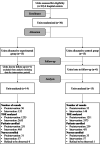Effectiveness of a 'do not interrupt' vest intervention to reduce medication errors during medication administration: a multicenter cluster randomized controlled trial
- PMID: 34429095
- PMCID: PMC8383384
- DOI: 10.1186/s12912-021-00671-7
Effectiveness of a 'do not interrupt' vest intervention to reduce medication errors during medication administration: a multicenter cluster randomized controlled trial
Abstract
Background: The use of a 'do not interrupt' vest during medication administration rounds is recommended but there have been no controlled randomized studies to evaluate its impact on reducing administration errors. We aimed to evaluate the impact of wearing such a vest on reducing such errors. The secondary objectives were to evaluate the types and potential clinical impact of errors, the association between errors and several risk factors (such as interruptions), and nurses' experiences.
Methods: This was a multicenter, cluster, controlled, randomized study (March-July 2017) in 29 adult units (4 hospitals). Data were collected by direct observation by trained observers. All nurses from selected units were informed. A 'Do not interrupt' vest was implemented in all units of the experimental group. A poster was placed at the entrance of these units to inform patients and relatives. The main outcome was the administration error rate (number of Opportunities for Error (OE), calculated as one or more errors divided by the Total Opportunities for Error (TOE) and multiplied by 100).
Results: We enrolled 178 nurses and 1346 patients during 383 medication rounds in 14 units in the experimental group and 15 units in the control group. During the intervention period, the administration error rates were 7.09% (188 OE with at least one error/2653 TOE) for the experimental group and 6.23% (210 OE with at least one error/3373 TOE) for the control group (p = 0.192). Identified risk factors (patient age, nurses' experience, nurses' workload, unit exposition, and interruption) were not associated with the error rate. The main error type observed for both groups was wrong dosage-form. Most errors had no clinical impact for the patient and the interruption rates were 15.04% for the experimental group and 20.75% for the control group.
Conclusions: The intervention vest had no impact on medication administration error or interruption rates. Further studies need to be performed taking into consideration the limitations of our study and other risk factors associated with other interventions, such as nurse's training and/or a barcode system.
Trial registration: The PERMIS study protocol (V2-1, 11/04/2017) was approved by institutional review boards and ethics committees (CPP Ile de France number 2016-A00211-50, CNIL 21/03/2017, CCTIRS 11/04/2016). It is registered at ClinicalTrials.gov (registration number: NCT03062852 , date of first registration: 23/02/2017).
Keywords: Hospital / organization & administration (MeSH); Interruptions; Medication errors/nursing* (MeSH); Medication errors/prevention and control (MeSH); Nursing staff; Safety management / organization & administration* (MeSH); Vest.
© 2021. The Author(s).
Conflict of interest statement
The authors declare that they have no competing interests.
Figures
References
-
- Allan EL, Barker KN. Fundamentals of medication error research. Am J Hosp Pharm. 1990;47(3):555–571. - PubMed
Associated data
LinkOut - more resources
Full Text Sources
Medical



